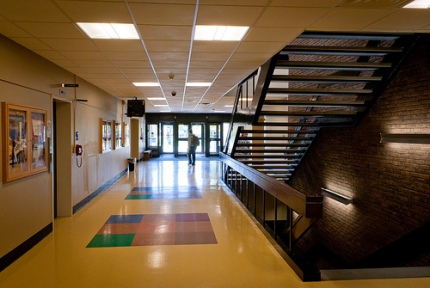Researchers Offer New Solution to Active Shooter Mitigation
08/10/2012 -Colleges and universities seeking to reduce casualties on campus during anactive shooter incident should invest in networked technologies that would limit the gunman’s access to easy targets, according to a master’s thesis from two graduate students at the Naval Postgraduate School.
In their dissertation, Defeating the Active Shooter: Applying Facility Upgrades in Order to Mitigate the Effects of Active Shooters in High Occupancy Facilities (.pdf), Charles E. Ergenbright and Sean K. Hubbard argue that the current approaches to preventing and mitigating active shooter incidents are not enough after analyzing 14 case studies, from Charles Whitman’s University of Texas-Austin tower shootings in 1966 to Seung Hui Cho’smassacre at Virginia Tech in 2007.
According to Ergenbright and Hubbard, psychological screening and behavioral threat assessments, while necessary, will not discover every person at risk of becoming an active shooter, particularly because an active shooter may not even be part of the campus community. They also argue that no matter how well-trained and prepared a police force is to respond appropriately to an active shooter event, and they note that most are not, there will always be time lapses between the first shot, the alarm, and officer response.
The average active shooter incident lasts 12.5 minutes while the average law enforcement response time takes 18 minutes, according to the Department of Homeland Security. At Virginia Tech, Cho’s rampage lasted 11 minutes. During that time, he fired 174 rounds, killing 30 people and wounding 17 others before turning the gun on himself.
Thus, four “immutable realities” of active shooter incidents arise from their research and analysis, write Ergenbright and Hubbard:
First, these acts of extreme violence cannot be prevented despite a university’s best effort to do so. Second, there will always be a delay between initiation of violence and Law Enforcement response. Third, in the time separating the first and last shots fired in Active Shooter incidents the only individuals who have the capacity to react are the victims and potential victims. The fourth and final immutable reality of these incidents is that with current security configurations within U.S. [institutions of higher learning], the only individual predominantly in control during an Active Shooter incident is the shooter himself.
Ergenbright and Hubbard argue colleges and universities should invest in what they call a Victim Initiated Mitigation (VIM) system. The system relies on those in danger to initiate the system (unless gunshot detection technology is added to the system), which then triggers automated responses to protect victims and to corral the shooter, thereby making it easier for police officers to go direct-to-threat and neutralize the gunman.
Once the system is initiated through an emergency call box installed in each room, an incident command center is alerted and two-way communications established while electromagnetic doors across campus automatically release and lock. (The doors, however, only lock on the outside, giving victims the ability to flee the room if an active shooter is present.) Hand-held devices networked to the call boxes and distributed to first responders provide situational awareness. Responding officers also carry key fobs that can open any locked door equipped with a proximity reader. Throughout, the incident command command communicates with potential victims and responding officers to give life-saving intelligence, such as where the active shooter is currently, while alsoalerting the campus community of the incidentand what protocols to follow.Ergenbright and Hubbard believe the lockdown feature of the system is the most critical to saving lives.
With facility lock down complete, First Responders are able to respond more rapidly and to a more controlled environment. For instance, after facility lock down has been initiated, if an Active Shooter exits the room he was in, he will not be able to reenter that room or enter any other rooms. Therefore, First Responders are more likely to know prior to entering the facility that the shooter is either in the Target Area identified by the ICC, or in a hallway. As a result, valuable time is not wasted clearing rooms that only contain potential victims.
The facility upgrades advocated within the paper, however, are expensive. Ergenbright and Hubbard estimate that upgrading each classroom within a building will cost $3,000. At Virginia Tech, for instance, the researchers calculate that active shooter facility upgrades would cost the university $40 million dollars. To pay for the VIM system, the researchers suggest universities interested in pursuing the concept tack on a $200 security fee to each student’s tuition per year. Under this scheme,Virginia Tech could pay for the security upgrades in less than seven years.
Ergenbright and Hubbard believe the initial capital investment will translate in a significant reduction in casualties. According to their analysis,Virginia Tech could reduce their vulnerabilityto an active shooter incident by 84 percent after installing a VIM.
Looking for a historical precedent for their VIM recommendation, Ergenbright and Hubbard compare their proposal to fire safety policies, procedures, and technology implemented during the late 1940s into the 1950s, which have reduced the death toll of school fires to zero after 1958.
“As the primary focus of this research is aimed at reducing the Rate of Kill of Active Shooters in U.S. [colleges and universities], we feel that the recommendations made in this thesis...could have the same notable impact to Active Shooter mitigation as implementation of the fire alarm and current fire code has had on preventing fire related casualties,” they conclude.
